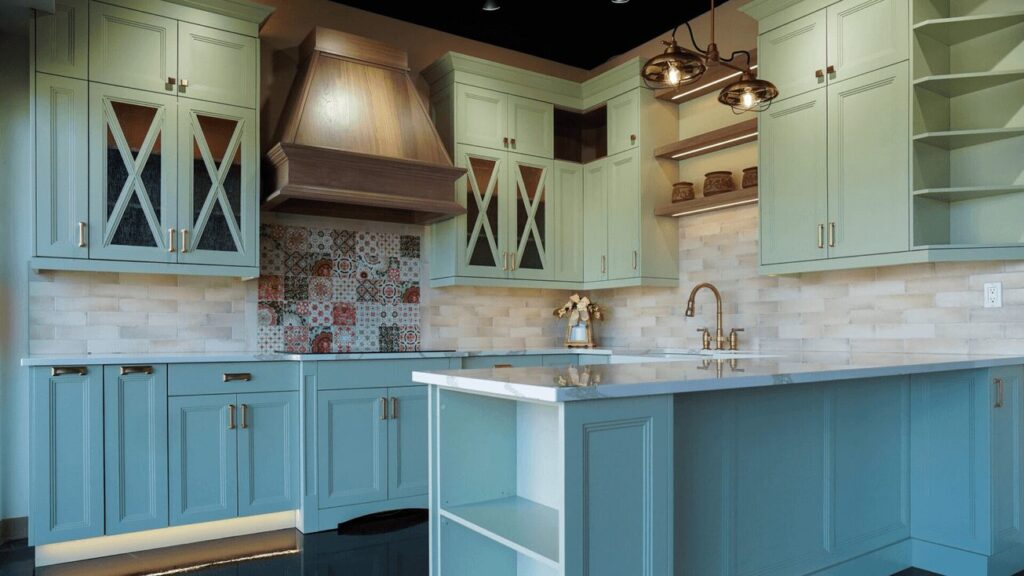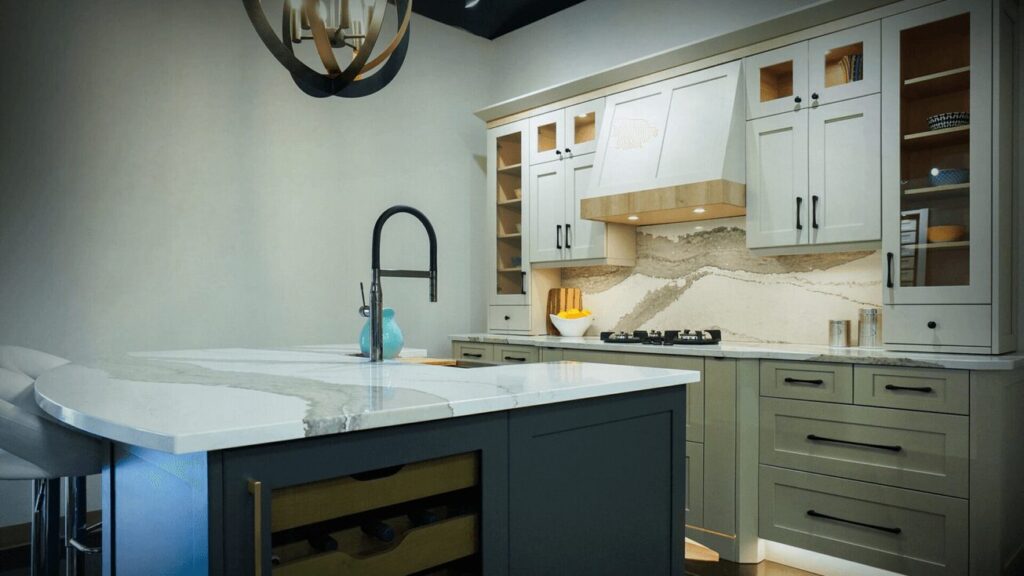
When it comes to kitchen or bathroom renovations, countertops are one of the most important decisions you’ll make. They serve as the focal point of your space, influencing both the aesthetic and functionality of the room. The right countertop can seamlessly combine beauty and durability while aligning with your budget and lifestyle needs. Whether you’re preparing meals in your kitchen or grooming in your bathroom, the surface you choose will impact how you use the space daily.
This guide will walk you through everything you need to consider when selecting the perfect countertop. We’ll explore a variety of materials, examine their pros and cons, discuss maintenance requirements, provide insights on costs, and offer design advice to help you bring your vision to life. With this comprehensive guide, you’ll be well-equipped to make an informed decision for your home renovation project.
Selecting the Perfect Countertop: Kitchen vs. Bathroom Needs
When choosing materials or planning renovations, it’s essential to start by considering the unique needs of the space you’re working on. Kitchens and bathrooms serve very different purposes, and their requirements reflect those differences. Understanding these needs will help you make practical decisions that balance function and design.
Kitchen
Kitchens are high-traffic areas that require durable, hard-working materials. Heat resistance is essential for surfaces near stoves or ovens, and stain protection is a must when dealing with food spills, oils, or sauces. Additionally, selecting food-safe materials for countertops ensures your kitchen stays hygienic and safe for meal preparation. For families, especially those with children, durability and easy cleaning become even more important.
Bathroom
Bathrooms, on the other hand, are all about moisture management. Materials need to resist water damage, mould, and humidity. Aesthetics also play a significant role here, as bathrooms often serve as a retreat or a place to relax. Low-maintenance options are ideal for guest or family bathrooms, saving time and effort while keeping the space looking polished. For homes with children, slip resistance and safety features might also be a priority.
Practicality Before Design
Before diving into design choices, it’s important to let practicality guide your decisions. Think about who will use the space and how it will be used—whether it’s a family kitchen, a single cook’s workspace, or a guest bathroom. Tailoring your materials and layout to the specific demands of these spaces will ensure they are not only beautiful but also functional and long-lasting.
Assess Your Lifestyle and Habits
Choosing the right materials for your home isn’t just about looks; it’s also about how they fit with your daily life. Before making any decisions, take a step back and evaluate your lifestyle, habits, and priorities. The right choice will depend on how you use your spaces and what you value most.
- Ask Key Questions:
- Do you cook or bake frequently? If so, you’ll need surfaces that are durable, heat-resistant, and easy to clean.
- Is your bathroom a high-traffic area? This might influence your choice of moisture-resistant and low-maintenance materials.
- Do you prefer easy upkeep, or are you okay with materials that require regular maintenance?
- Real-World Examples:
- If you’re a passionate home chef, materials like quartz or granite are excellent for a kitchen that sees a lot of activity. They’re durable, resistant to scratches, and can handle the heat of hot pots or pans.
- For a bathroom that’s primarily used as a guest powder room, you might opt for something like laminate or marble, which can offer a luxurious feel without the need for heavy-duty durability.
- Busy households with kids or pets might prioritize materials that can withstand wear and tear, such as engineered stone or vinyl floors.
Countertop Materials Overview: Finding the Best Fit for Your Space

Choosing the right countertop material is one of the most important decisions when designing a kitchen or bathroom. Each material comes with its own set of advantages and challenges, whether you’re looking for durability, style, or affordability. Below, we break down the most popular countertop materials to help you weigh their pros and cons and find the perfect match for your needs.
Quartz
- Overview: Quartz is an engineered stone made by combining natural quartz with resins and pigments. It’s one of the most durable and low-maintenance options available today.
- Pros: Highly durable, non-porous, and resistant to stains, scratches, and bacteria. Available in a wide range of colours and patterns, making it a versatile choice for modern kitchens.
- Cons: While quartz is resilient, it is not heatproof and can be damaged by extreme heat. It’s also one of the more expensive options.
- Best For: Busy kitchens where low maintenance and durability are key.
Granite
- Overview: Granite is a natural stone that brings a unique, high-end look to any space. It’s heat-resistant and incredibly strong, but it requires proper care to maintain its appearance.
- Pros: Heat-resistant, scratch-resistant, and each slab is one of a kind, adding character to your kitchen. Great for achieving a timeless or luxurious aesthetic.
- Cons: Requires periodic sealing to maintain its non-porous qualities and can chip if not properly cared for. It’s also on the pricier side.
- Best For: High-end or classic kitchen designs where natural beauty is a priority.
Marble
- Overview: Marble is synonymous with elegance and luxury. Its smooth, cool surface makes it a popular choice for baking and pastry preparation.
- Pros: Beautiful and timeless, ideal for creating a statement in bathrooms, kitchens, or specialized baking zones.
- Cons: Highly porous, prone to staining and scratching, and requires regular maintenance to preserve its look. It’s more delicate than other stones.
- Best For: Bathrooms or baking areas where elegance outweighs durability needs.
Laminate
- Overview: Laminate is a budget-friendly option made of layered plastic fused to particleboard, offering a wide range of designs and patterns.
- Pros: Affordable, easy to install, and available in endless styles, including options that mimic stone or wood.
- Cons: Less durable and prone to burns, scratches, or peeling over time. Not as long-lasting as premium materials.
- Best For: Rental properties, secondary spaces, or budget-conscious renovations.
Butcher Block
- Overview: Butcher block countertops are made from strips of wood bonded together to create a warm, natural appearance. They’re especially popular in farmhouse or rustic kitchens.
- Pros: Adds warmth and character, perfect for prep areas or casual, cozy spaces. It can be sanded down if scratched.
- Cons: Requires regular oiling to prevent drying or cracking. Susceptible to water damage and not ideal for areas near sinks or dishwashers.
- Best For: Prep stations or kitchens with a natural, rustic aesthetic.
Solid Surface (e.g., Corian)
- Overview: Solid surface countertops are made of acrylic or polyester resins and are known for their seamless appearance and versatility.
- Pros: Non-porous, easy to clean, and available in various colours and patterns. It can be repaired if scratched or damaged.
- Cons: Less heat-resistant than natural stone options like granite or quartz. Can be prone to scratching.
- Best For: Mid-range kitchens that need a sleek, customizable look.
Porcelain
- Overview: Porcelain is a high-end, ultra-durable material gaining popularity in Canada. It’s made from ceramic clay and baked at high temperatures, making it incredibly strong.
- Pros: Extremely heat and scratch-resistant, UV stable, and non-porous. Perfect for indoor and outdoor use.
- Cons: Higher price point and newer to the market, which may limit some customization options.
- Best For: Modern, high-end kitchens or outdoor applications requiring durability and style.
Final Thoughts
When selecting a countertop material, it’s essential to consider your lifestyle, budget, and design preferences. Whether you prioritize durability, affordability, or aesthetics, there’s a material to suit every need. Take the time to evaluate how you use your space to ensure your choice not only looks great but also stands up to daily life.
Matching Countertops With Your Cabinetry and Design Style
Choosing the right countertop is about more than just functionality; it’s a key element in tying together your kitchen’s overall aesthetic. A well-chosen countertop can enhance your cabinetry, complement your design style, and even become a bold statement piece. Here are some tips to help you achieve a cohesive and beautiful look:
- Coordinate Your Colour Palette: Decide whether you want your countertops to harmonize with your cabinetry or create contrast. Neutral tones, like whites and greys, can provide timeless elegance, while bold contrasting colours can add visual interest and personality.
- Explore Finish Options: The finish of your countertop can dramatically alter its appearance. Matte and honed finishes offer a subtle, understated look, while polished surfaces add shine and sophistication. For a more tactile appeal, consider textured finishes that bring depth and character to your space.
- Make a Statement When it Fits: In some cases, a statement countertop can redefine your kitchen’s entire look. Opt for bold veining in natural stone or a dramatic waterfall edge to create a focal point that draws the eye and sparks conversation.
- Work Toward Cohesion in Open-Concept Designs: If you have an open-concept floor plan, ensure your countertop complements not just the kitchen but the surrounding spaces as well. Repeating colours, materials, or finishes in subtle ways can help create a seamless flow throughout your home.
Maintenance Considerations
Choosing the right countertop material isn’t just about aesthetics—it’s also about how much effort you’re willing to put into upkeep. Different materials have different maintenance needs, so it’s important to understand what’s involved before making a decision. Below, we’ll break down sealing requirements, daily cleaning routines, and recommended cleaners for some popular materials, along with a quick-reference maintenance chart.
Sealing Requirements
Some materials, like granite, marble, and concrete, require regular sealing to maintain their durability and appearance. Sealing protects porous surfaces from stains, moisture, and bacteria. For example:
- Granite: Needs sealing every 1–2 years, depending on usage.
- Marble: Requires sealing more frequently due to its high porosity.
- Concrete: Should be sealed every 1–3 years to prevent cracking and staining.
Daily Cleaning Needs
Not all materials are created equal when it comes to daily maintenance. Here’s how common countertop options compare:
- Quartz: Very low maintenance. A simple wipe with warm water and mild soap is enough. It’s non-porous, so it doesn’t need sealing.
- Butcher Block: Requires regular oiling to prevent drying out and cracking. Cleaning should be gentle to avoid damaging the wood.
- Marble: Needs extra care as it’s prone to scratching and staining. Use a soft cloth and pH-neutral cleaner to avoid damage.
Recommended Cleaners
Using the right cleaner ensures your counters stay in great shape. Here are some suggestions:
- Quartz: Mild soap and water or a non-abrasive surface cleaner.
- Marble: pH-neutral stone cleaner to avoid etching.
- Laminate: Gentle all-purpose cleaner or a mix of water and vinegar for tough spots.
- Butcher Block: A mix of warm water and vinegar or a food-safe wood cleaner.
Maintenance Chart
Here’s a quick overview of maintenance requirements for popular materials:
- Quartz: Low maintenance
- Marble: High maintenance
- Laminate: Low maintenance
- Butcher Block: Moderate to high maintenance
Durability and Longevity
When choosing materials, durability and longevity are key factors to consider. Understanding how well a material holds up over time with proper care can help you make an informed decision. Different materials offer varying levels of resistance, which can impact their lifespan and performance in day-to-day use.
- Lifespan Comparison: Examine how long different materials last when maintained correctly. Some materials may require more care but offer a significantly longer lifespan.
- Scratch Resistance: Assess how prone the material is to scratches, especially if it will be exposed to frequent use or abrasive surfaces.
- Heat Resistance: Consider whether the material can withstand high temperatures without warping, discolouring, or degrading.
- Moisture Tolerance: Determine how well the material handles exposure to water or humidity, particularly for areas like kitchens or bathrooms.
- Stain Resistance: Evaluate the material’s ability to resist common stains from food, beverages, or other substances, ensuring it remains presentable over time.
Final Tips for Choosing the Right Countertop
Choosing the right countertop is a big decision that impacts both the style and functionality of your space. Here are some final tips to help you make the best choice:
- Always see samples in person: Photos online can be misleading when it comes to colour, texture, and finish. Visiting a showroom or requesting samples ensures you know exactly what you’re getting. Touch and feel the material to understand its texture and how it fits your vision.
- Ask for durability and stain tests: Especially for materials like marble, it’s important to understand how they handle everyday wear and tear. Some materials may stain easily or require more upkeep. Don’t hesitate to ask the supplier for demonstrations or test the samples yourself with common spills like wine, coffee, or oil.
- Work with a contractor or designer: A professional can help you optimize your countertop layout, ensuring functional sink cutouts, seamless edge profiles, and properly aligned seams. They can also provide insight into what materials work best for your lifestyle and kitchen or bathroom design.
- Think long-term: Trends come and go, but countertops are an investment you’ll live with for years. Ask yourself if you’ll still love the material, colour, and finish in five or ten years. Consider how it will age and whether it fits your maintenance preferences over time.
Conclusion
Choosing the right countertop is about finding the perfect balance between material, budget, lifestyle, and design. Each of these factors plays a crucial role in ensuring your countertop not only looks stunning but also functions well for your daily needs. By aligning these elements, you can create a space that reflects your style while being practical and durable.
Remember, the process doesn’t have to feel overwhelming. With the right guidance and a clear understanding of your priorities, finding the ideal countertop becomes a manageable and rewarding experience. Whether you’re seeking elegance, durability, or affordability, the perfect countertop is within reach, ready to elevate your space and meet your needs for years to come.
Ready to upgrade your kitchen or bathroom with the perfect countertop? Contact MOD Kitchens to book a consultation. Our design experts can help you choose the best materials for your space, lifestyle, and budget.
